Page 28 SKODA OCTAVIA 2005 1.G / (1U) Owner's Manual
[x] Cancel search | Manufacturer: SKODA, Model Year: 2005, Model line: OCTAVIA, Model: SKODA OCTAVIA 2005 1.G / (1U)Pages: 315, PDF Size: 11.8 MB
Page 282 of 315

Breakdown assistance281
Using the systemSafetyDriving TipsGeneral MaintenanceBreakdown assistanceTechnical Data
Securing wheels against being stolen*
You need a special adapter for slackening the safety
wheel bolts.
– Pull off the full wheel trim/cap from the wheel hub or cap from
the safety wheel bolt.
– Push the adapter with its toothed side into the inner toothing of the safety wheel bolt right down in such a way
that only the outer hexagon is jutting out ⇒fig. 211.
– Push the wheel wrench fully onto the adapter .
– Slacken the wheel bolt, or tighten it firmly ⇒page 279.
– Reinstall the full wheel trim/wheel cap after removing the adapter or place the cap onto the safety wheel bolt. – Have the
tightening torque checked with a torque wrench as
soon as possible. Steel and light alloy wheels must be tight-
ened to a tightening torque of 120 Nm.
The safety wheel bolts on vehicles fitted with them (one safety wheel bolt
per wheel) can only be loosened or tighten up by using the adapter
provided.
It is meaningful to note the code number hammered into the rear side of
the adapter or the rear side of the safety wheel bolts. You can obtain a
replacement adapter from a Škoda dealer, if necessary, by quoting this
number.
We recommend that you always carry the adapter for the wheel bolts with
you in the vehicle. It should be stowed in the vehicle tool kit.
Caution
Damage can occur to the adapter and safety wheel bolt if the safety wheel
bolt is tightened up too much.
Note
The set of safety wheel bolts can be obtained from your Škoda dealer.
Jump-starting
Initial steps
You can use the battery of another vehicle for jump-starting yours if the
engine does not start because the battery on your vehicle is flat. You will
require jump-start cables for this purpose.
Fig. 211 Safety wheel
bolt with adapter
AB
AA
AB
s24s.book Page 281 Thursday, November 24, 2005 12:27 PM
Page 283 of 315

Breakdown assistance
282
Both batteries must have a rated voltage of 12 V. The capacity (Ah) of the
battery supplying the power must not be significantly less than the
capacity of the discharged battery in your vehicle.
Jump-start cables
Only use jump-start cables which have an adequately large cross-section
and insulated terminal clamps. Please pay attention to the manufacturer's
instructions.
Positive cable - colour coding in the majority of cases red.
Negative cable - colour coding in the majority of cases black.
WARNING
•A discharged battery may already freeze at temperatures just
below 0°C. In case of frozen battery carry out no jump-starting - risk
of explosion!
•Please pay attention to the warning instructions relating to
working in the engine compartment ⇒page 248.
Note
•There must not be any contact between the two vehicles otherwise
current may flow as soon as the negative terminals are connected.
•The discharged battery must be properly connected to the system of
the vehicle.
•Switch off any mobile phone, pay attention to the instructions for use
of the mobile phone in such a situation.
•We recommend purchasing jump-start cables from a Škoda dealer as
a Škoda original accessory or from retailers who sell branded batteries.
Starting engine
It is important to connect the jump-start cables in the correct
order:
Connecting positive terminals
– Attach one end to the positive terminal ⇒fig. 212 of the
discharged battery .
– Attach the other end to the positive terminal of the battery supplying the power .
Connecting negative terminal and engine block
– Attach one end to the negative terminal of the battery supplying the power .
Fig. 212 Jump-starting
using the battery from
another vehicle: A - flat
vehicle battery, B -
battery providing
current
A1
AA
A2
AB
A3
AB
s24s.book Page 282 Thursday, November 24, 2005 12:27 PM
Page 284 of 315
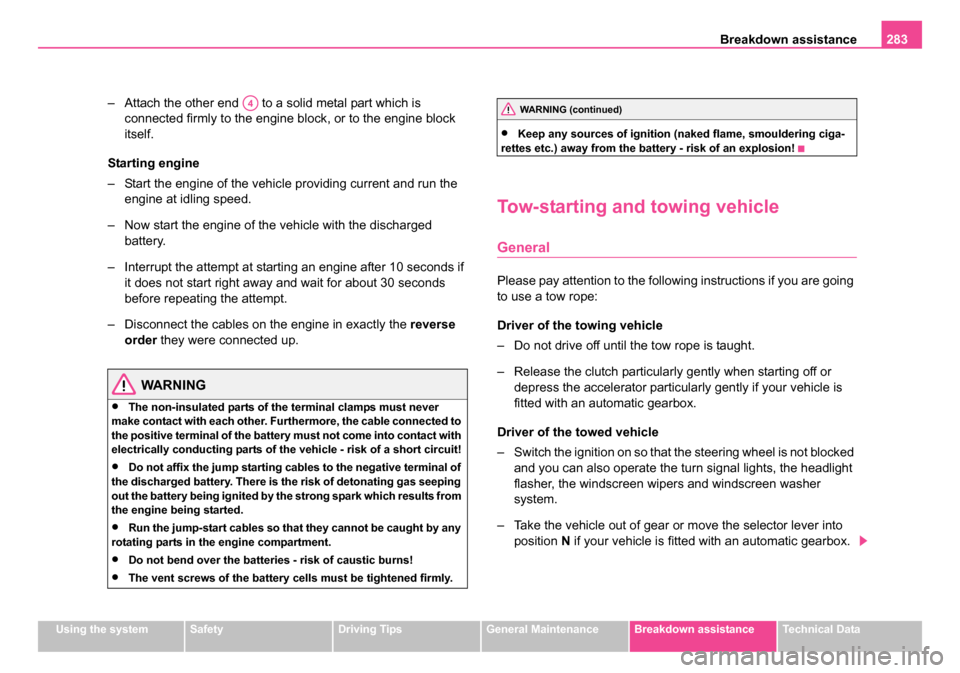
Breakdown assistance283
Using the systemSafetyDriving TipsGeneral MaintenanceBreakdown assistanceTechnical Data
– Attach the other end to a solid metal part which is
connected firmly to the engine block, or to the engine block
itself.
Starting engine
– Start the engine of the vehicle providing current and run the engine at idling speed.
– Now start the engine of the vehicle with the discharged battery.
– Interrupt the attempt at starting an engine after 10 seconds if it does not start right away and wait for about 30 seconds
before repeating the attempt.
– Disconnect the cables on the engine in exactly the reverse
order they were connected up.
WARNING
•The non-insulated parts of the terminal clamps must never
make contact with each other. Furthermore, the cable connected to
the positive terminal of the battery must not come into contact with
electrically conducting parts of the vehicle - risk of a short circuit!
•Do not affix the jump starting cables to the negative terminal of
the discharged battery. There is the risk of detonating gas seeping
out the battery being ignited by the strong spark which results from
the engine being started.
•Run the jump-start cables so that they cannot be caught by any
rotating parts in the engine compartment.
•Do not bend over the batteries - risk of caustic burns!
•The vent screws of the battery cells must be tightened firmly.
•Keep any sources of ignition (naked flame, smouldering ciga-
rettes etc.) away from the battery - risk of an explosion!
Tow-starting and towing vehicle
General
Please pay attention to the following instructions if you are going
to use a tow rope:
Driver of the towing vehicle
– Do not drive off until the tow rope is taught.
– Release the clutch particularly gently when starting off or depress the accelerator particularly gently if your vehicle is
fitted with an automatic gearbox.
Driver of the towed vehicle
– Switch the ignition on so that the steering wheel is not blocked and you can also operate the turn signal lights, the headlight
flasher, the windscreen wipers and windscreen washer
system.
– Take the vehicle out of gear or move the selector lever into position N if your vehicle is fitted with an automatic gearbox.
A4WARNING (continued)
s24s.book Page 283 Thursday, November 24, 2005 12:27 PM
Page 285 of 315
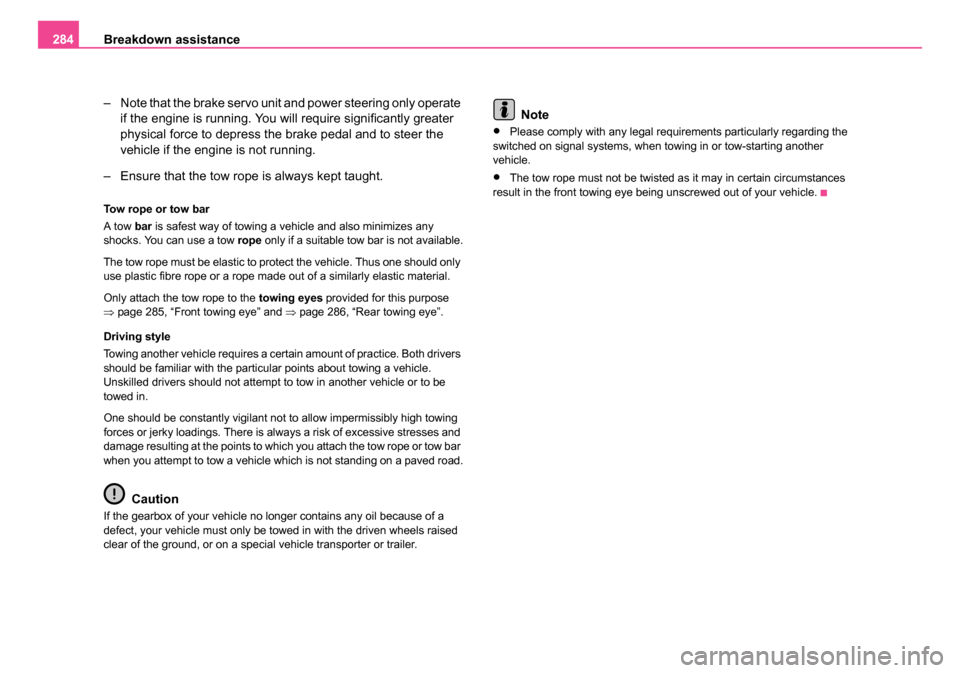
Breakdown assistance
284
– Note that the brake servo unit and power steering only operate if the engine is running. You will require significantly greater
physical force to depress the brake pedal and to steer the
vehicle if the engine is not running.
– Ensure that the tow rope is always kept taught.
Tow rope or tow bar
A tow bar is safest way of towing a vehicle and also minimizes any
shocks. You can use a tow rope only if a suitable tow bar is not available.
The tow rope must be elastic to protect the vehicle. Thus one should only
use plastic fibre rope or a rope made out of a similarly elastic material.
Only attach the tow rope to the towing eyes provided for this purpose
⇒ page 285, “Front towing eye” and ⇒page 286, “Rear towing eye”.
Driving style
Towing another vehicle requires a certain amount of practice. Both drivers
should be familiar with the particular points about towing a vehicle.
Unskilled drivers should not attempt to tow in another vehicle or to be
towed in.
One should be constantly vigilant not to allow impermissibly high towing
forces or jerky loadings. There is always a risk of excessive stresses and
damage resulting at the points to which you attach the tow rope or tow bar
when you attempt to tow a vehicle which is not standing on a paved road.
Caution
If the gearbox of your vehicle no longer contains any oil because of a
defect, your vehicle must only be towed in with the driven wheels raised
clear of the ground, or on a special vehicle transporter or trailer.
Note
•Please comply with any legal requirements particularly regarding the
switched on signal systems, when towing in or tow-starting another
vehicle.
•The tow rope must not be twisted as it may in certain circumstances
result in the front towing eye being unscrewed out of your vehicle.
s24s.book Page 284 Thursday, November 24, 2005 12:27 PM
Page 286 of 315
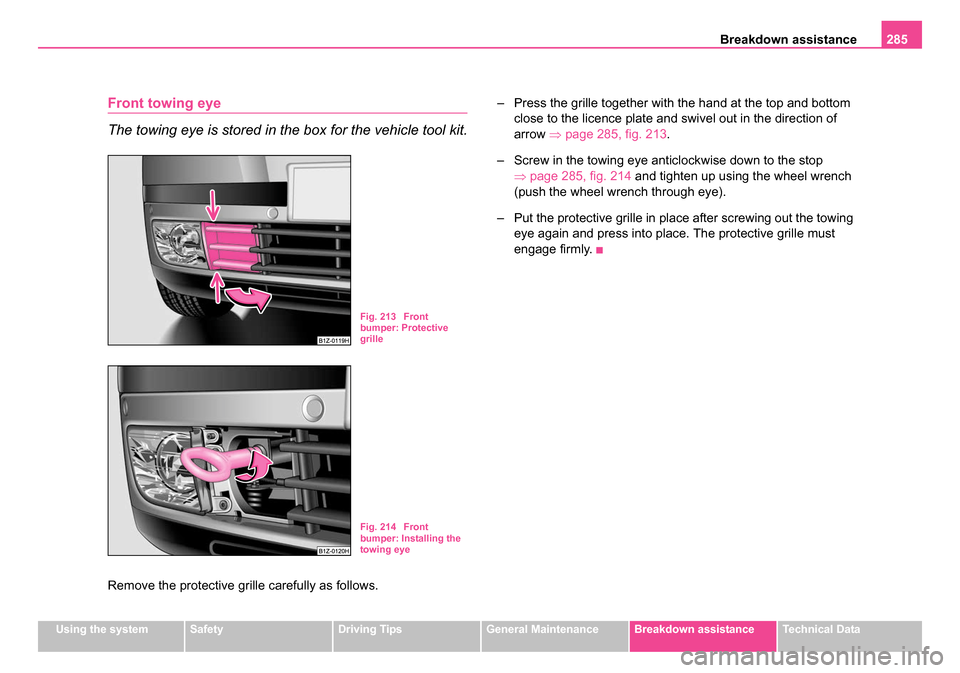
Breakdown assistance285
Using the systemSafetyDriving TipsGeneral MaintenanceBreakdown assistanceTechnical Data
Front towing eye
The towing eye is stored in the box for the vehicle tool kit.
Remove the protective grille carefully as follows. – Press the grille together with the hand at the top and bottom
close to the licence plate and swivel out in the direction of
arrow ⇒ page 285, fig. 213 .
– Screw in the towing eye anticlockwise down to the stop ⇒page 285, fig. 214 and tighten up using the wheel wrench
(push the wheel wrench through eye).
– Put the protective grille in place after screwing out the towing eye again and press into place. The protective grille must
engage firmly.
Fig. 213 Front
bumper: Protective
grille
Fig. 214 Front
bumper: Installing the
towing eye
s24s.book Page 285 Thursday, November 24, 2005 12:27 PM
Page 287 of 315
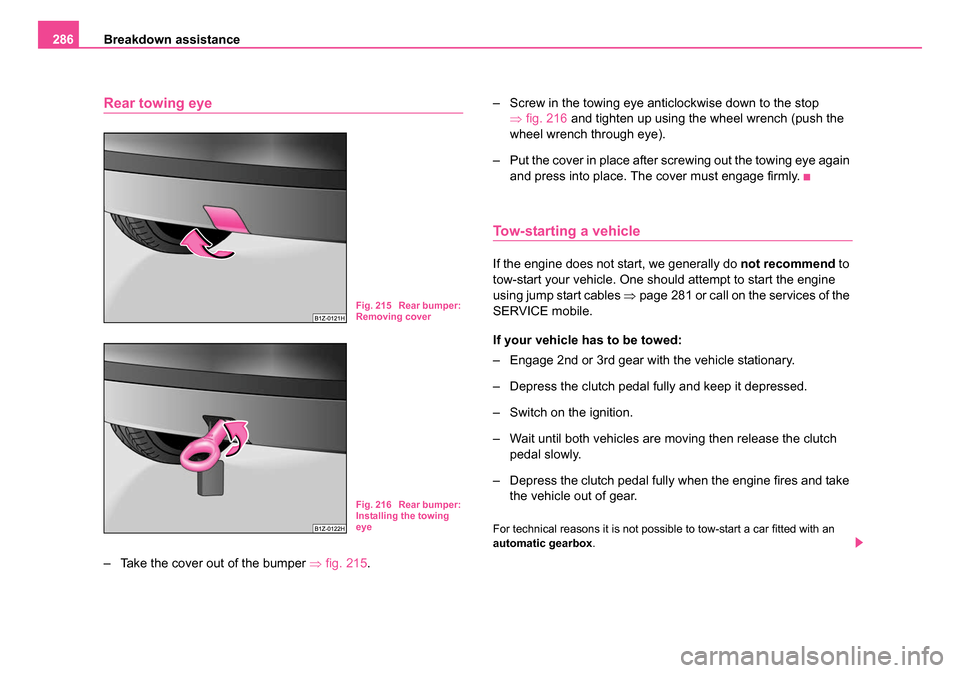
Breakdown assistance
286
Rear towing eye
– Take the cover out of the bumper ⇒fig. 215 . – Screw in the towing eye anticlockwise down to the stop
⇒fig. 216 and tighten up using the wheel wrench (push the
wheel wrench through eye).
– Put the cover in place after screwing out the towing eye again and press into place. The cover must engage firmly.
Tow-starting a vehicle
If the engine does not start, we generally do not recommend to
tow-start your vehicle. One should attempt to start the engine
using jump start cables ⇒page 281 or call on the services of the
SERVICE mobile.
If your vehicle has to be towed:
– Engage 2nd or 3rd gear with the vehicle stationary.
– Depress the clutch pedal fully and keep it depressed.
– Switch on the ignition.
– Wait until both vehicles are moving then release the clutch pedal slowly.
– Depress the clutch pedal fully when the engine fires and take the vehicle out of gear.
For technical reasons it is not possible to tow-start a car fitted with an
automatic gearbox .
Fig. 215 Rear bumper:
Removing cover
Fig. 216 Rear bumper:
Installing the towing
eye
s24s.book Page 286 Thursday, November 24, 2005 12:27 PM
Page 288 of 315
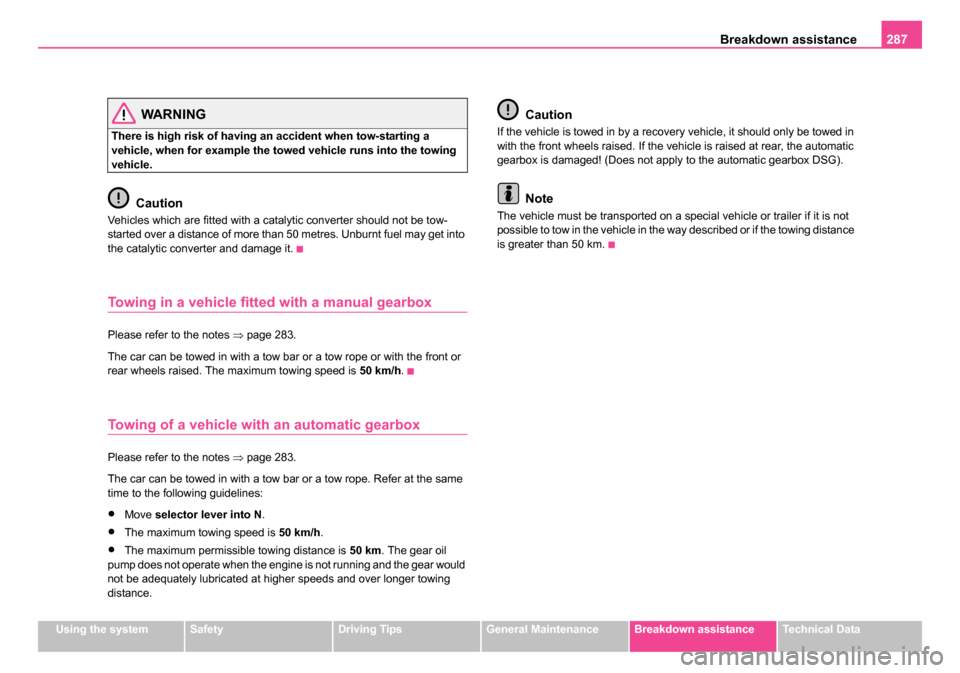
Breakdown assistance287
Using the systemSafetyDriving TipsGeneral MaintenanceBreakdown assistanceTechnical Data
WARNING
There is high risk of having an accident when tow-starting a
vehicle, when for example the towed vehicle runs into the towing
vehicle.
Caution
Vehicles which are fitted with a catalytic converter should not be tow-
started over a distance of more than 50 metres. Unburnt fuel may get into
the catalytic converter and damage it.
Towing in a vehicle fitted with a manual gearbox
Please refer to the notes ⇒page 283.
The car can be towed in with a tow bar or a tow rope or with the front or
rear wheels raised. The maximum towing speed is 50 km/h.
Towing of a vehicle with an automatic gearbox
Please refer to the notes ⇒page 283.
The car can be towed in with a tow bar or a tow rope. Refer at the same
time to the following guidelines:
•Move selector lever into N .
•The maximum towing speed is 50 km/h.
•The maximum permissible towing distance is 50 km. The gear oil
pump does not operate when the engine is not running and the gear would
not be adequately lubricated at higher speeds and over longer towing
distance.
Caution
If the vehicle is towed in by a recovery vehicle, it should only be towed in
with the front wheels raised. If the vehicle is raised at rear, the automatic
gearbox is damaged! (Does not apply to the automatic gearbox DSG).
Note
The vehicle must be transported on a special vehicle or trailer if it is not
possible to tow in the vehicle in the way described or if the towing distance
is greater than 50 km.
s24s.book Page 287 Thursday, November 24, 2005 12:27 PM
Page 289 of 315
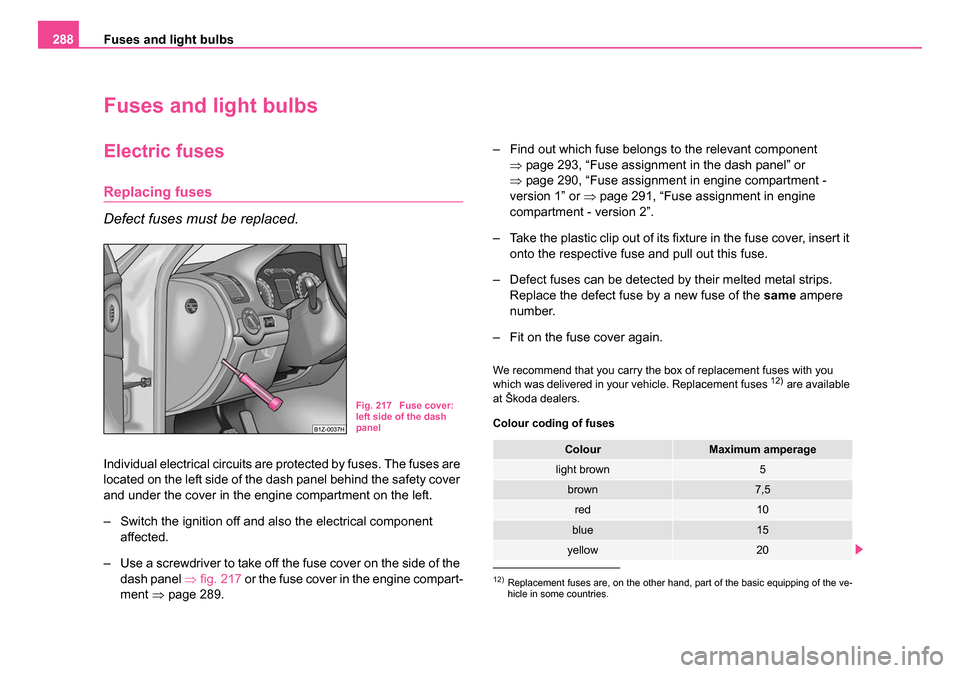
Fuses and light bulbs
288
Fuses and light bulbs
Electric fuses
Replacing fuses
Defect fuses must be replaced.
Individual electrical circuits are protected by fuses. The fuses are
located on the left side of the dash panel behind the safety cover
and under the cover in the engine compartment on the left.
– Switch the ignition off and also the electrical component
affected.
– Use a screwdriver to take off the fuse cover on the side of the dash panel ⇒fig. 217 or the fuse cover in the engine compart-
ment ⇒page 289. – Find out which fuse belongs to the relevant component
⇒page 293, “Fuse assignment in the dash panel” or
⇒ page 290, “Fuse assignment in engine compartment -
version 1” or ⇒page 291, “Fuse assignment in engine
compartment - version 2”.
– Take the plastic clip out of its fixture in the fuse cover, insert it onto the respective fuse and pull out this fuse.
– Defect fuses can be detected by their melted metal strips. Replace the defect fuse by a new fuse of the same ampere
number.
– Fit on the fuse cover again.
We recommend that you carry the box of replacement fuses with you
which was delivered in your vehicle. Replacement fuses 12) are available
at Škoda dealers.
Colour coding of fuses
Fig. 217 Fuse cover:
left side of the dash
panel
12)Replacement fuses are, on the other hand, part of the basic equipping of the ve-
hicle in some countries.
ColourMaximum amperage
light brown5
brown7,5
red10
blue15
yellow20
s24s.book Page 288 Thursday, November 24, 2005 12:27 PM
Page 290 of 315

Fuses and light bulbs289
Using the systemSafetyDriving TipsGeneral MaintenanceBreakdown assistanceTechnical Data
Caution
•Never attempt to “repair” fuses and also do not replace them with a
fuse of a higher amperage - risk of fire! This may also cause damage at
another part of the electrical system.
•Have the electrical system checked as quickly as possible by a
specialist garage if a newly inserted fuse blows again after a short time.
Fuse cover in engine compartment
The fuse box in the engine compartment exists in two
different versions. You can determine which version your
vehicle is fitted with after removing the fuse cover at the
location of the fuses.
For particular model versions, the battery must be removed
before removing the fuse cover ⇒page 258.
Removing fuse cover
– Move the circlips ⇒fig. 218 as far as the stop, the symbol
appears behind the circlip and remove the cover.
Installing fuse cover
– Position the fuse cover on the fuse box and push the circlips as far as the stop - the symbol
is visible behind the
circlip.
white25
green30
orange40
red50
ColourMaximum amperage
Fig. 218 Fuse cover in
engine compartment
AA
AA
s24s.book Page 289 Thursday, November 24, 2005 12:27 PM
Page 291 of 315
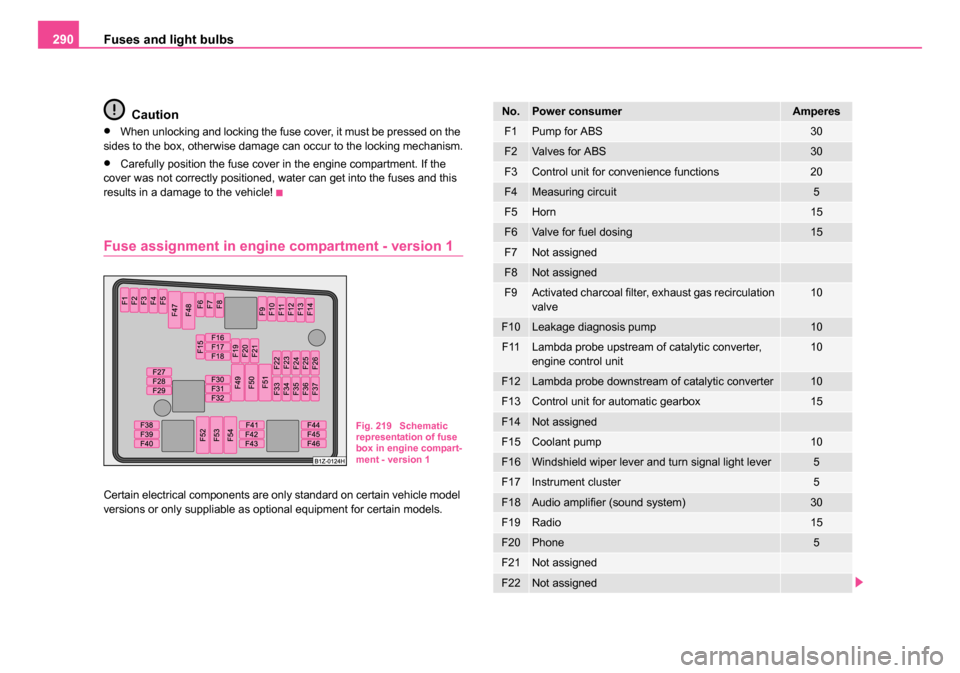
Fuses and light bulbs
290
Caution
•When unlocking and locking the fuse cover, it must be pressed on the
sides to the box, otherwise damage can occur to the locking mechanism.
•Carefully position the fuse cover in the engine compartment. If the
cover was not correctly positioned, water can get into the fuses and this
results in a damage to the vehicle!
Fuse assignment in engine compartment - version 1
Certain electrical components are only standard on certain vehicle model
versions or only suppliable as optional equipment for certain models.
Fig. 219 Schematic
representation of fuse
box in engine compart-
ment - version 1
No.Power consumerAmperes
F1Pump for ABS30
F2Valves for ABS30
F3Control unit for convenience functions20
F4Measuring circuit5
F5Horn15
F6Valve for fuel dosing15
F7Not assigned
F8Not assigned
F9Activated charcoal filter, exhaust gas recirculation
valve10
F10Leakage diagnosis pump10
F11Lambda probe upstream of catalytic converter,
engine control unit10
F12Lambda probe downstream of catalytic converter10
F13Control unit for automatic gearbox15
F14Not assigned
F15Coolant pump10
F16Windshield wiper lever and turn signal light lever5
F17Instrument cluster5
F18Audio amplifier (sound system)30
F19Radio15
F20Phone5
F21Not assigned
F22Not assigned
s24s.book Page 290 Thursday, November 24, 2005 12:27 PM